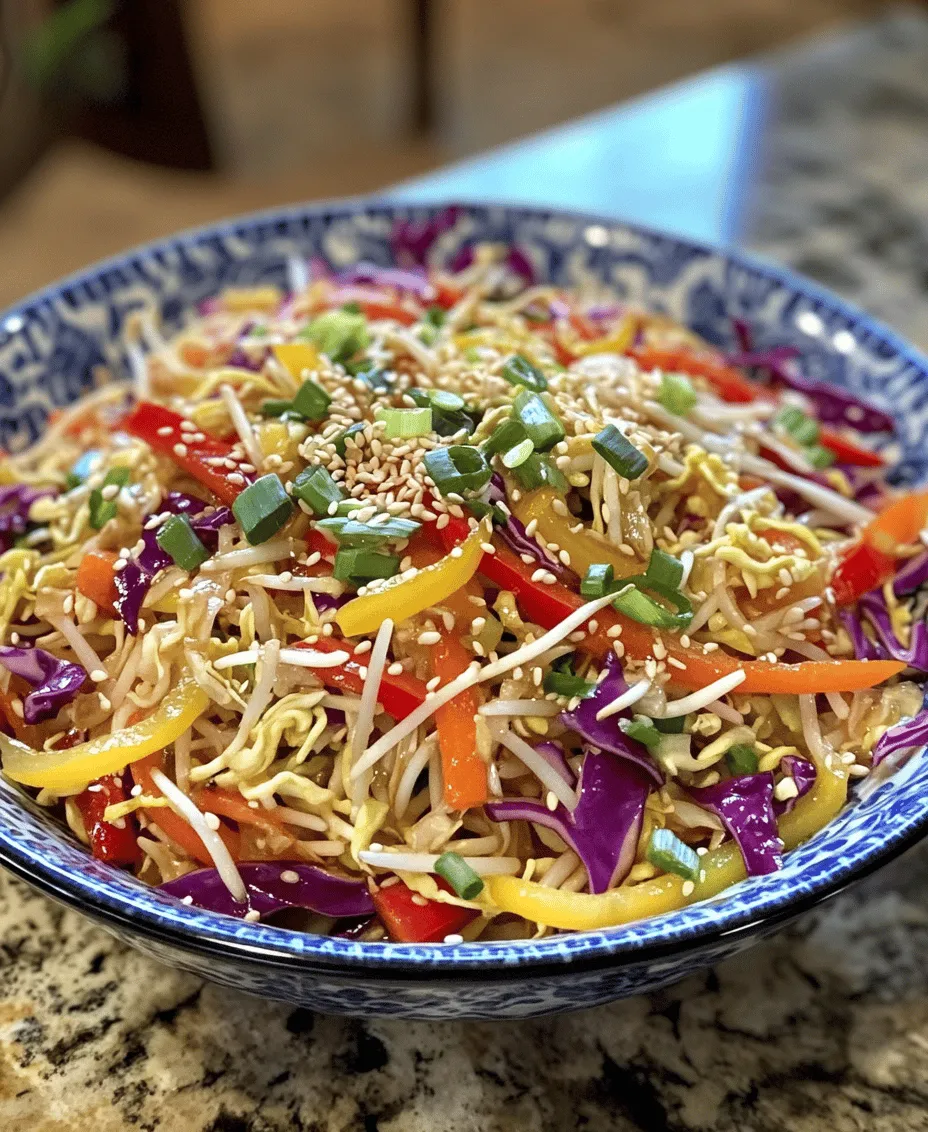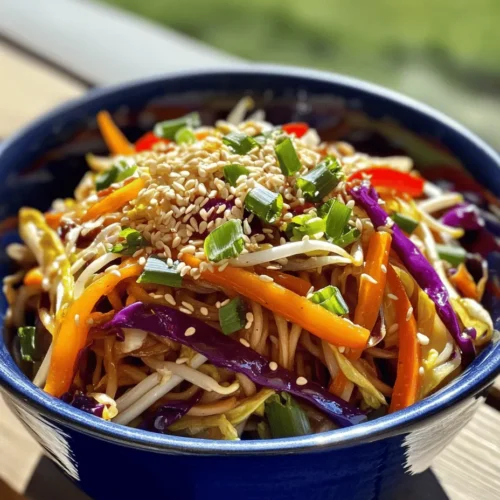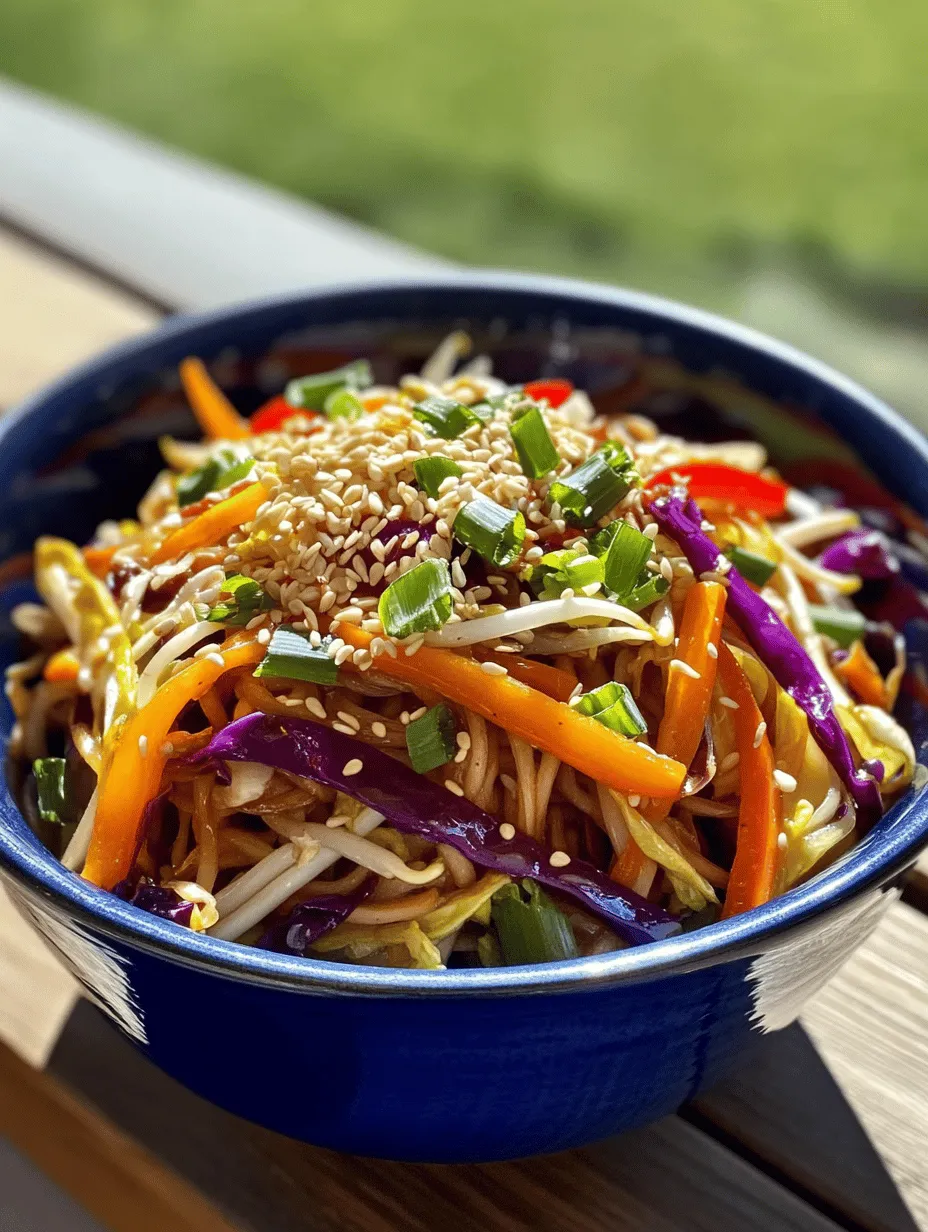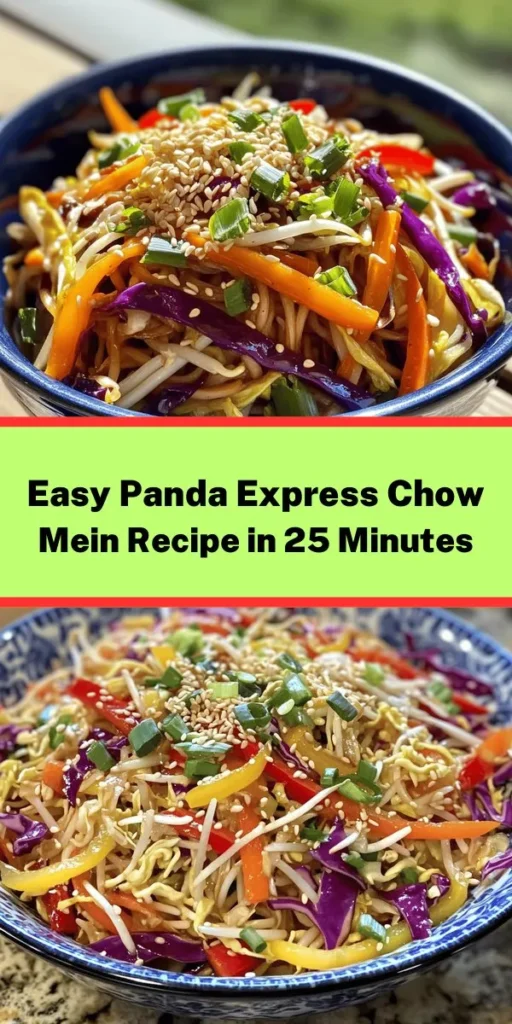Introduction
Chow mein, a beloved staple in both Chinese and Western cuisine, has captured the hearts—and appetites—of food lovers around the world. Inspired by the iconic dish served at Panda Express, this homemade version of chow mein promises to deliver that same delightful flavor and texture right in your kitchen. The beauty of making chow mein at home lies not only in its ease of preparation but also in the opportunity to use fresh ingredients and customize the dish to your liking. Whether you prefer extra vegetables, a protein boost, or a spice kick, this recipe allows you to make chow mein your way.
Chow mein’s cultural significance is deeply rooted in Asian cuisine, where it has long been a popular dish due to its versatility and satisfying nature. The term “chow mein” translates to “stir-fried noodles,” and it encompasses a variety of styles and preparations that showcase the vibrant flavors of fresh vegetables, savory sauces, and hearty noodles. Its widespread appeal across different palates makes chow mein a go-to choice for family dinners, meal prep, and quick weeknight meals.
In this article, we will explore the origins and evolution of chow mein, discuss the essential ingredients that make this dish sing, and provide you with a step-by-step guide to creating your very own Wok-tastic Panda Express-Inspired Chow Mein. Get ready to bring the flavors of your favorite Chinese takeout right to your dining table!
Understanding Chow Mein
The origins of chow mein trace back to the Chinese immigrants who introduced this dish to the United States in the late 19th century. Traditionally, chow mein consists of stir-fried noodles paired with an assortment of vegetables and protein, creating a satisfying meal that can be enjoyed in various forms. The dish has evolved over the years, leading to several regional variations that reflect local tastes and ingredients.
In China, there are two main styles of chow mein: steamed and crispy. Steamed chow mein features soft noodles stir-fried with vegetables, while crispy chow mein, often popular in Western adaptations, boasts a crunchy texture achieved by frying the noodles until golden brown. In the United States, chow mein has been adapted further, often incorporating ingredients such as bean sprouts, carrots, and cabbage, all tossed in a savory sauce.
Fast-casual dining establishments like Panda Express have popularized chow mein, making it a staple on their menus. The quick-cooking method and vibrant flavors appeal to customers looking for a delicious and filling meal. However, making chow mein at home not only gives you control over the ingredients but also allows for creativity in customizing the dish to suit your preferences.
Essential Ingredients for Chow Mein
Creating a memorable chow mein dish requires a thoughtful selection of ingredients that contribute to its flavor, texture, and nutritional value. Here’s a breakdown of the key components you’ll need for your Wok-tastic Panda Express-Inspired Chow Mein:
Chow Mein Noodles
The foundation of any great chow mein is the noodles. Chow mein noodles are typically made from wheat flour and can be found in both fresh and dried varieties. Fresh chow mein noodles are often softer and require less cooking time, while dried noodles need to be boiled before stir-frying. When selecting your noodles, aim for the freshest option available, as they provide the best texture and flavor. The cooking method is crucial; you want your noodles to be cooked al dente, providing a perfect bite that holds up against the stir-frying process.
Fresh Vegetables
Using fresh, seasonal vegetables is essential for creating a vibrant and flavorful chow mein. Common vegetables include bell peppers, carrots, broccoli, snow peas, and cabbage. These vegetables not only add color and crunch but also pack in essential vitamins and minerals. Incorporating a variety of vegetables ensures that your chow mein is not just delicious but also nutritious, making it a well-rounded meal. Feel free to experiment with your favorite vegetables or whatever is in season to create a unique twist on this classic dish.
Aromatics
Garlic and ginger are the dynamic duo of Asian cuisine, and they play a vital role in enhancing the flavor profile of chow mein. Garlic adds a rich, savory depth, while ginger brings a warm, zesty kick. When preparing your chow mein, finely mince or grate these aromatics to release their essential oils and flavors. Sautéing them at the beginning of the cooking process will infuse your dish with a fragrant aroma that will have your taste buds tingling in anticipation.
Sauces
No chow mein is complete without the right sauces that tie all the flavors together. Soy sauce is a staple in Asian cooking, providing a salty, umami flavor that enhances the overall taste of the dish. For an extra layer of richness, consider adding oyster sauce, which introduces a subtle sweetness and depth. A drizzle of sesame oil at the end of the cooking process adds a nutty aroma and flavor, making your chow mein irresistible. Together, these sauces create a harmonious balance that elevates the dish from simple noodles to a culinary delight.
Step-by-Step Cooking Process
Now that you have a solid understanding of the essential ingredients, it’s time to dive into the cooking process. Follow this comprehensive guide to prepare your Wok-tastic Panda Express-Inspired Chow Mein, ensuring you achieve that perfect blend of flavors and textures.
Cooking the Noodles
1. Choose Your Noodles: Begin by selecting your chow mein noodles. If you’re using fresh noodles, they will require less cooking time compared to dried noodles.
2. Boiling the Noodles: If you are using dried chow mein noodles, bring a large pot of water to a rolling boil. Add the noodles and cook them according to the package instructions, typically around 5-7 minutes, until they are just al dente. Stir occasionally to prevent sticking.
3. Draining and Rinsing: Once the noodles are cooked, drain them in a colander and rinse them under cold water. This step stops the cooking process and helps to remove excess starch, ensuring your noodles don’t clump together.
4. Tossing with Oil: After rinsing, toss the noodles with a small amount of oil (such as sesame oil or vegetable oil) to prevent them from sticking. This will also add a lovely flavor to the noodles.
5. Set Aside: Set the prepared noodles aside while you cook the vegetables and aromatics.
By following these initial steps for preparing your chow mein noodles, you set the stage for a delicious dish that captures the essence of your favorite Panda Express-inspired chow mein. In the next section, we will tackle the stir-frying process, where the real magic happens as you combine the noodles with fresh vegetables, aromatics, and sauces. Stay tuned for the continuation of this culinary adventure!

Heating the Wok
When it comes to stir-frying, the heat of your wok is paramount. A properly heated wok allows for quick cooking, which is essential for maintaining the vibrant colors and textures of your ingredients. Start by preheating your wok over medium-high heat for about 2-3 minutes. The goal is to get the surface hot enough that when you drizzle in your oil, it shimmers and spreads quickly across the surface.
For oil selection, opt for oils with high smoke points, such as canola oil, peanut oil, or avocado oil. These oils not only withstand high temperatures without burning but also add a subtle flavor that complements your chow mein. Avoid olive oil for this recipe, as its lower smoke point can lead to bitterness when heated too high. Once your oil is hot, you’re ready to start the cooking process, ensuring that your ingredients will sear beautifully and develop that coveted wok hei flavor.
Sautéing Aromatics
Sautéing aromatics is the next critical step in creating a flavor-packed chow mein. Begin by adding minced garlic and ginger to the hot wok. The timing here matters significantly; you want to sauté these ingredients until they are fragrant but not burnt, which usually takes about 30 seconds to a minute. This rapid cooking releases essential oils and flavors that form the backbone of your dish.
Adding aromatics at the right moment means they will infuse the oil, which then flavors the noodles and vegetables. Keep your spatula moving to prevent them from sticking and burning. Once you can smell the aromatic scent wafting through your kitchen, it’s time to add the vegetables.
Vegetable Preparation
To achieve that delightful crunch in your chow mein, select fresh vegetables such as bell peppers, bean sprouts, carrots, and snow peas. These not only add color but also a variety of textures. When preparing vegetables, slice them into uniform pieces; this ensures even cooking.
Start with the sturdier vegetables like carrots and bell peppers, which take longer to soften. Add them to the wok first and stir-fry for a couple of minutes before introducing quicker-cooking vegetables like bean sprouts and snow peas. This staggered approach allows all ingredients to be perfectly cooked while retaining their crispness. The goal is to have tender vegetables that retain that satisfying crunch, providing a delightful contrast to the soft noodles.
Combining Ingredients
Once your vegetables are cooked to perfection, it’s time to introduce the star of the dish: the chow mein noodles. If you’re using pre-cooked noodles, ensure they’re slightly cooled and loosened to avoid clumping. Add the noodles to the wok, gently tossing them with the sautéed vegetables.
To combine everything evenly, use a folding motion with your spatula, gently lifting and turning the noodles to coat them with the aromatic oil and vegetable juices. This technique ensures that every strand absorbs the flavors, creating a harmonious dish. Be cautious not to overmix, as you want to maintain the texture of the vegetables while warming the noodles through.
Seasoning
Now comes the moment to season your chow mein! The beauty of this dish lies in its ability to be tailored to your taste. Start by adding soy sauce, which gives the chow mein its signature umami flavor. A splash of oyster sauce can enhance the depth further, while sesame oil adds a nutty aroma that elevates the overall experience.
Taste as you go, adjusting the seasoning according to your preference. If you enjoy a hint of heat, consider adding a dash of chili oil or some freshly chopped red chili peppers. Remember, it’s easier to add more seasoning than to take it away, so start lightly and build up the flavor profile. This step is crucial as it transforms your chow mein from a simple noodle dish into a flavorful masterpiece.
Final Touches
Presentation is key in making your chow mein not just delicious but visually appealing. Once your chow mein is cooked and seasoned, it’s time to add those final touches. Consider garnishing with sliced green onions and sesame seeds. The green onions add a fresh, crisp bite, while sesame seeds contribute a delightful crunch and enhance the dish’s visual appeal.
For an extra kick, you can serve with lime wedges on the side. A squeeze of lime over your chow mein just before eating brightens the flavors and provides a refreshing contrast to the savory elements of the dish. These simple garnishes can elevate your chow mein from home-cooked to restaurant-quality.
Nutritional Analysis of Chow Mein
Understanding the nutritional profile of your chow mein can help you appreciate its health benefits. A standard serving of homemade chow mein typically contains around 400-500 calories, depending on the ingredients used. The macronutrient breakdown generally includes approximately 15-20 grams of protein, 60-70 grams of carbohydrates, and 10-15 grams of fat.
The vegetables add a wealth of vitamins and minerals, such as vitamin A from carrots, vitamin C from bell peppers, and fiber from bean sprouts. Incorporating a variety of vegetables not only enhances the flavor but also increases the nutritional value of the dish. For those looking to make chow mein healthier, consider using whole grain noodles or adding additional vegetables to increase fiber content while reducing the overall calorie density.
Customizing Your Chow Mein
The beauty of chow mein lies in its versatility. You can easily customize it to cater to various dietary preferences. For a vegetarian or vegan version, simply replace the oyster sauce with a mushroom-based alternative or skip it altogether. For protein options, chicken, beef, shrimp, or tofu can be added. If using meat, it’s best to cook it first until browned and set aside before adding vegetables, ensuring that everything cooks evenly.
For gluten-free options, choose rice noodles or gluten-free soy sauce. Adjust the cooking times accordingly, as different proteins and noodles may require specific methods to ensure they’re cooked properly. Don’t hesitate to experiment with other vegetables or sauces to make your chow mein unique to your taste.
Serving Suggestions
Chow mein is a fantastic standalone dish, but it shines even brighter when paired with complementary sides. Consider serving it alongside a light cucumber salad dressed with rice vinegar for a refreshing contrast or crispy spring rolls for added texture. If you’re looking for a heartier meal, you might serve it with a sweet and sour chicken or beef dish to balance the flavors.
For a complete dining experience, conclude your meal with a light dessert, such as mango pudding or fortune cookies, to capture that authentic Panda Express feel. This approach not only enhances the meal but also makes it a memorable occasion for family and friends.
Conclusion
Homemade chow mein is a delightful dish that brings the flavors of your favorite Chinese restaurant into your kitchen. With its customizable nature, it caters to a variety of tastes and dietary needs, making it a perfect choice for any gathering. By following the steps outlined in this recipe, you can create a delicious and satisfying meal that is sure to impress.
Cooking is not just about feeding ourselves; it’s about sharing love and joy with those around us. So gather your ingredients, heat that wok, and embark on a culinary adventure that will fill your home with enticing aromas and create lasting memories. Whether you enjoy it alone or share it with loved ones, this chow mein promises to deliver a taste of comfort and satisfaction. Enjoy your cooking journey!



